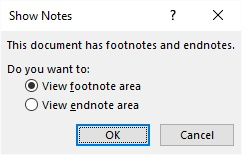Please Note: This article is written for users of the following Microsoft Word versions: 2007, 2010, 2013, 2016, 2019, 2021, 2024, and Word in Microsoft 365. If you are using an earlier version (Word 2003 or earlier), this tip may not work for you. For a version of this tip written specifically for earlier versions of Word, click here: Converting Individual Endnotes and Footnotes.
Written by Allen Wyatt (last updated February 22, 2025)
This tip applies to Word 2007, 2010, 2013, 2016, 2019, 2021, 2024, and Word in Microsoft 365
Word is flexible on whether a note is considered an endnote or a footnote. You can easily convert between the two, but the way you do the conversion is not necessarily intuitive. To convert from an endnote to a footnote (or vice versa), follow these steps:

Figure 1. The Show Notes dialog box.
As you convert each endnote or footnote, it is moved to the other window and the reference marks for the note are updated to what is currently being used for the series (footnote or endnote) to which you are converting.
WordTips is your source for cost-effective Microsoft Word training. (Microsoft Word is the most popular word processing software in the world.) This tip (11757) applies to Microsoft Word 2007, 2010, 2013, 2016, 2019, 2021, 2024, and Word in Microsoft 365. You can find a version of this tip for the older menu interface of Word here: Converting Individual Endnotes and Footnotes.

Learning Made Easy! Quickly teach yourself how to format, publish, and share your content using Word 2021 or Microsoft 365. With Step by Step, you set the pace, building and practicing the skills you need, just when you need them! Check out Microsoft Word Step by Step today!
If you want to modify how footnote numbers look in your document, you can modify them manually. Of course, there are ...
Discover MoreWhen you add footnotes to a document, you expect the footnote reference numbers to be visible when you print the ...
Discover MoreWhen using full justification of your text, you may get extra spaces in places you never wanted. This tip examines one ...
Discover MoreFREE SERVICE: Get tips like this every week in WordTips, a free productivity newsletter. Enter your address and click "Subscribe."
There are currently no comments for this tip. (Be the first to leave your comment—just use the simple form above!)
Got a version of Word that uses the ribbon interface (Word 2007 or later)? This site is for you! If you use an earlier version of Word, visit our WordTips site focusing on the menu interface.
Visit the WordTips channel on YouTube
FREE SERVICE: Get tips like this every week in WordTips, a free productivity newsletter. Enter your address and click "Subscribe."
Copyright © 2025 Sharon Parq Associates, Inc.
Comments